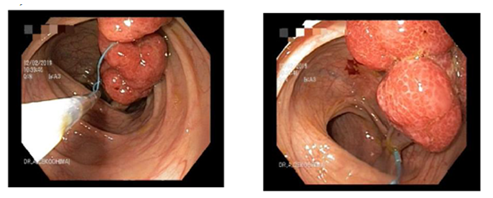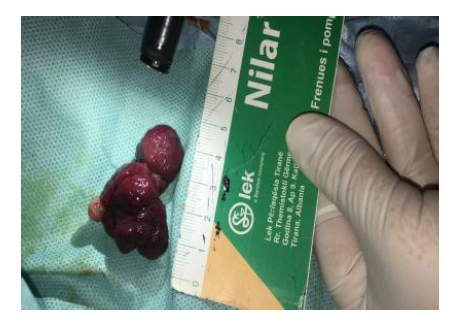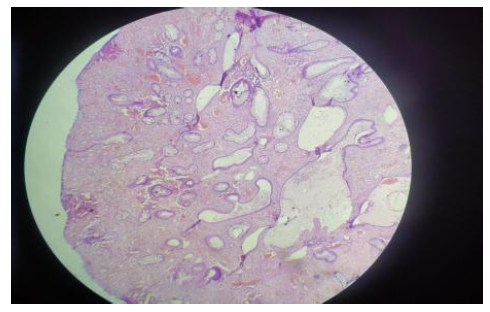Information
Journal Policies
High Value of Fecal Calprotectin Detected a Giant Colonic Polyp in a Child - Case Report
V.Velmishi1*, A Cekodhima2, G.Cekodhima3, P.Cullufe1
2.Endoscopic center "La Vita" Tirana, Albania.
3.Service of histopathology, Mother Teresa Hospital-Tirana, Albania.
Copyright : © 2019 . This is an open access article distributed under the Creative Commons Attribution License, which permits unrestricted use, distribution, and reproduction in any medium, provided the original work is properly cited.
Fecal calprotectin levels are commonly measured even in children to exclude the diagnosis of inflammatory bowel disease (IBD). Juvenile polyps are a rare form of colonic polyp found in both adults and children. We would like to describe a case of a 9-year-old boy who was presented with a very high fecal calprotectin level, without significant gastrointestinal signs due to a giant complex polyp.
Polyp, fecal calprotectin
1. Introduction
Calprotectin is an intracellular calcium and zinc binding protein found in the cytosol of neutrophils with bacteriostatic and fungistatic properties [1,2]. Fecal calprotectin is used as an noninvasive biomarker for intestinal inflammation and has mainly been associated with active IBD [3]. Traditionally a high level of fecal calprotectin in chidren has been correlated with mucosal inflammation such as inflammatory bowel disease, infectious diarrhea, necrotizing enterocolitis, and diverticular disease [4]. Several studies confirm that fecal calprotectin is very sensible in diagnostic of solitary polyps [5] such as in our case.
2. Case Report
A 9-year- old boy was referred to gastroenterologist pediatrician because of mild abdominal pain and iron deficiency anemia. He was the first child of an Albanian couple without consanguinity. Pregnancy and delivery were normal. He was never hospitalized before. According to his parents he had been several times in consultation with hematologist because of a mild iron deficiency anemia. The parents denied to have noticed blood in stool. diarrhea or weight loss. He was treated only with oral iron medications. During objective examination heart rate was 92/min, lungs auscultation was normal. Liver and spleen were not enlarged. Weight was 34 kg ( 58% percentile) and height was 137 cm (percentile 48%). Lab studies showed: WBC=5,4X103/mm3 ;RBC=4.62x 106/ mm3 ;Hgb=11,1g/dl ; HCT=34,8 MCV=78fL ; PLT-297X103/mm3. In biochemical examinations were noticed a low level of sideremia. The rest of examinations was normal. An abdominal ultrasound didn`t reveal any abnormalities. Serology for celiac disease resulted negative. To exclude an inflammatory bowel disease we demanded fecal calprotectine which resulted very high 860 mg/kg (normal range for children over 5 year- old we consider until 150 mg/kg). In our practice we use Cal Fast (Eurospital S.p. A-Trieste, Italy) a rapid immunoassay for the quantitative determination of fecal calprotectin. In this context was mandatory to perform digestive endoscopy. Upper digestive endoscopy resulted normal whereas colonoscopy showed a giant pedunculated complex polyp(4,5cm x 3,4 cm x 3,6 cm) in tranvers colon (Figure 1 and 2). Polypectomy was performed without any complications. Specimen was send to pathology for further evaluation. Microscopic examination reveals an edematous lamina propria with inflammatory cells and cystically dilated glands lined by columnar epithelium with reactive changes. The dilated glands are filled with mucus and inflammatory debris. These data were compatible with colonic juvenile polyp (Figure 3).
3. Discussion
Juvenile polyps are found in children investigating for blood in stool, IBD or accidentally detected during colonoscopy. The reported prevalence ranges between 0.08% and 3.7 % among children and most frequently diagnosed between 3 and 10 years with a male predominance [6] the occurrence of juvenile polyp is underestimated such as in our case because of occult clinical presentation without moderate painless hematochezia. In one –third of children the most clinical feature remains microcytic anemia as a result of chronic blood loss [7,8] which misleads us to suspicion of inflammatory bowel disease. Olafsdottir et al reported that children with juvenile polyps had elevated levels of fecal calprotectin compared to children with normal colonoscopies, but less elevated compared to children with inflammatory bowel disease [9] There is a debate about the size, number and type of polyps and fecal calprotectin level. Pauley –Hunter et al argued the fecal calprotectin does appear to correlate with the degree of inflammation present and some other studies suggest that inflammatory response is not related to the type or size of polypoid lesions but is probably related to the immunological status of the patient [10]. In our case our value of fecal calprotectin was very high corresponding with the size of polyp. Juvenil polyps belong to the the group of benign hamartomas, which are the most common of gastrointestinal tumors during childhood and can be presented as a solitary polyp or as a multiple polyps in the juvenile polyposis syndrome [11]. Juvenile polyposis syndrome remains a premalignant condition whereas solitary polips are considered as being sporadic with small to no risk for malignancy [12]. There is no surveillance program for children with having juvenile polyps. Recent data reveal that the recurrence rate of solitary polyps was 17 % and there exist case reports of neoplasia in children with solitary juvenile polyps [13,14]. In our case we recommended to reevaluate fecal calprotectin 3 months after polypectomy expecting a normal value. Our second recommendation to parents was a follow –up colonoscopy in next 12 months regarding the unusual size of polyp.
4. Conclusion
High value of fecal calprotectin in children should make the doctor to consider colonic polyps as a differential diagnosis to inflammatory bowel disease. Colonoscopy remains the best tool for the final diagnosis and follows up.
5. Consent
Written informed consent was obtained by the parents of our patient.
6. Authors' Contributions
V.V drafted the manuscript. G.C performed histological examination. A.C performed endoscopy and polypectomy. P.C reviews the manuscript. All authors read and approved the manuscript.
References
- Konikoff MR,Denson LA.Role of fecal calprotectin as a biomarker of intestinal inflammation in inflammatory bowel disease. Inflamm Bowel Dis. 2006;12:524-34.
- Montalto m, Gallo A ,Santoro L, et Al . Role of fecal calprotectin in gastrointestinal disorders. Eur Rev Med Pharmacol Sci 2013;17;1569-82.
- Fagerberg UL,Loof L, Merzoug RD,et Al. Fecal calprotectin levels in healthy children studied with an improved assay. J Pediatr Gastroenterol Nutr 2003;37:468-72.
- Vaos G, Kostakis ID, Zavras N, Chatzemichael A. The role of calprotectin in pediatric disease. BioMed Res Int.2013.
- Gutfeld O, Prus D, Ackerman Z, Dishon S, Linke RP,Levin M, Urieli-Shovai S (2006) Expression of serum amyloid A, in normal ,dysplastic , and neoplastic human colonic mucosa:implication for a role in colonic tumorigenesis. J Histochem Cytochem 54:63-73.
- Thakkar K, Alsarraj A, Fong E, et Al.Prevalence of colorectal polyps in pediatric colonoscopy.Dig Dis Sci 2012;57:1050-5.
- IBD working group of European Society For Pediatric Gastroenterology. Nutrition Inflamm atory bowel disease in children and adolescents: recommandations for diagnosis – the Porto criteria J Pediatr Gastroenterol Nutr 2005;41:1-7.
- Levine A, Koletzko S, Turner D et al. ESPGHAN revised porto criteria for the diagnosis of inflammatory bowel disease in children and adolescents.J Pediatr Gastroenterol Nutr 2014;58:795-806.
- Olafsdottir I,Nemeth A, Lorinc ,E,Toth E, Agarth D. Value of fecal calprotectin as a biomarker for juvenile polyps in children investigated with colonoscopy J Pediatr Gastroentrol Nutr.
- Pauley-Hunter R,Kunnath S, Wolff K, Vanderhoof JA.Fecal calprotectin and pediatric juvenile polyps. J Pediatr Gastroenetrol Nutr .2015;60:e30-e31.
- Fox VL,Perros S, Jiang H ,et al.Juvenil polyps: recurrence in patients with multiple and solitary polyps. Clin Gastroenterol Hepatol 2010;8:795-9.
- Giardiello FM, Hamilton SR,KernSe, et Al. Colorectal neoplasia in juvenile polyposis or juvenile polyps. Arch Dis Child 1991;66:971-5.
- Thakkar K, Fishman DS, Gilger MA. Colorectal polyps in childhood. Curr Opin Pediatr 2012 ;24:632-7.
- Giardello FM, Hamilton SR, Kern SE, et al. Colorectal neoplasia in juvenil polyposis or juvenile polyps. Arch Dis Child 1001;66:971-5.







